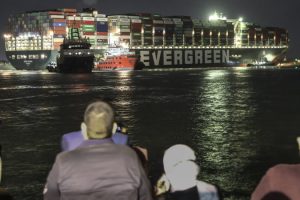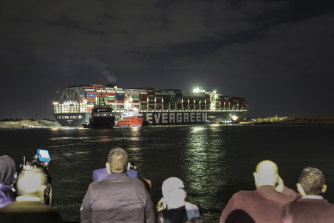The Suez Canal blockage wreaked economic havoc. Working out who will pay for it could take years

It took six days to prise free a giant container ship that ran aground and clogged the Suez Canal, one of the world’s most crucial shipping arteries. It could take years to sort out who will pay for the mess.
Cargo companies, insurers, government authorities and a phalanx of lawyers, all with different agendas and potential assessments, will not only need to determine the total damage but also what went wrong. When they eventually finish digging through the morass, the insurers of the ship’s Japanese owner are likely to bear the brunt of the financial pain.
Cargo companies, insurers, government authorities and a phalanx of lawyers, all with different agendas and potential assessments, will not only need to determine the total damage but also what went wrong.Credit:AP
The costs could add up quickly.
There are the repairs for any physical damage to the Ever Given, the quarter-mile-long ship that got stuck in the Suez. There is the bill for the tugboats and front-end loaders that dug the beached vessel out from the mud. The authority that operates the Suez Canal has already said the crisis has cost the Egyptian government up to $US90 million ($118 million) in lost toll revenue as hundreds of ships waited to pass through the blocked waterway or took other routes.
And the stalled ship held up as much as $US10 billion of cargo a day from moving through the canal, including cars, oil, livestock, laptops, sneakers, electronics and toilet paper. Companies delivering goods may have to pay customers for missed deadlines. If any agricultural goods went bad, producers may look to recoup lost revenue.
All of these cascading effects could amount to insurance claims in the hundreds of millions of dollars as well as broader losses from the delays in the global supply chain.
The sheer size of the Ever Given makes the situation all the more labyrinthine. Aside from time of war, the Suez Canal has never been blocked quite so spectacularly or for as long a time as it was with the Ever Given, and this is the biggest ship to run aground.
The financial mess will ensnare a multinational web of businesses, led by the Japanese owner of the ship, its Taiwanese operator and the German management agent that hired the crew, as well as myriad cargo companies that rented space in the ship’s containers and a sprawling pool of insurance firms stretching from Tokyo to London.
The ultimate responsibility may fall to the insurers for the ship’s owner, Shoei Kisen Kaisha, a subsidiary of the 120-year-old privately owned Japanese shipbuilder Imabari.
Teams from the German company that hired the crew and a consortium of insurers for the ship’s owner are just starting to investigate what caused the marooning of the Ever Given. Authorities in Panama, where the ship is registered, are also conducting an inquiry, as are investigators for other interested parties. Their findings, whether they align or not, will complicate questions of liability, keeping claims adjusters and lawyers busy for years as they sort through the finger-pointing.
Investigators want to know “who was responsible for the disruption — was it the crew, the pilots working for the Suez Canal Authority, or is it just an act of nature or a freak accident by the wind?” said Richard Oloruntoba, an associate professor of supply chain management at the Curtin Business School in Perth.
Even after inquiries are completed, Oloruntoba added, “it’s not clear-cut. It all depends on how good the lawyers are and also the contracts that were entered into.”
The most straightforward aspect is the damage to the ship and the canal. In the shipping business, those costs usually fall to the insurers of the ship’s owner — in this case, a consortium led by Mitsui Sumitomo Insurance in Tokyo with Tokio Marine and Sompo Japan. Initial reports indicate the ship did not suffer much harm, and there was no pollution leak.
The consortium is also likely to be on the hook for the salvage costs to free the ship, which swelled as experts and equipment were mobilised on short notice. Robert Mazzuoli, an insurance analyst at Fitch Ratings, estimated that bill could run into the tens of millions, although there are many variables.
The trickier piece of the puzzle is the cargo. Companies that booked containers on the Ever Given, as well as some of the 400 ships that had to wait in line outside the canal while it was jammed, may want to file claims.
But most insurance policies do not cover the economic losses for cargo delays. So companies will have to make a specific case as to why they are entitled to compensation.
Such claims could reach hundreds of millions of dollars.
The ships carrying the most time-sensitive cargo, such as livestock or produce, could make the strongest argument. Those vessels, though, were allowed to go through first once the waterway was cleared.
For the most part, claims around cargo might be “impractical,” said Jeff N.K. Lee, a lawyer in Taipei, Taiwan, who specialises in commercial and transportation law.
Adding to the complexity of the Suez accident are the layers upon layers of insurance. Reinsurers, companies that cover the risk of other insurance companies, come into play for claims above $US100 million. Between insurance and reinsurance, the ship’s owner has coverage for those third-party claims up to $US3.1 billion, although few experts believe the damages will run that high.
The sheer size of the Ever Given makes the situation all the more labyrinthine. Aside from time of war, the Suez Canal has never been blocked quite so spectacularly or for as long a time as it was with the Ever Given, and this is the biggest ship to run aground.
The ship is as long as the Empire State Building is tall, with the capacity to carry 20,000 containers stacked 12 to 14 high. The Ever Given is one of a fleet of 13 in a series designed by Imabari, part of a push to lower the costs per container and make the ships more competitive in an increasingly fierce market dominated by Chinese and South Korean shipbuilders.
“The bigger the ships get, the risk is, whenever you have an incident like this, is that you are putting more of your eggs into one basket,” said Simon Heaney, senior manager of container research at Drewry UK, a shipping consultancy. “So the claims will magnify.”
The New York Times
Most Viewed in Business
From our partners
Source: Read Full Article

